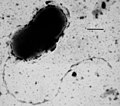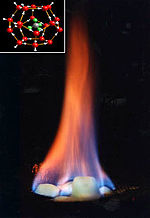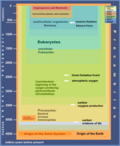sulfate-methane transition zone (SMTZ) is a zone in oceans, lakes, and rivers typically found below the sediment surface in which sulfate and methane...
18 KB (2,421 words) - 03:50, 4 April 2025
Dead zone (ecology) Hypoxia (environmental) Marine sediment Redox Redox potential Remineralization Sediment-water interface Sulfate-methane transition zone...
18 KB (1,621 words) - 13:10, 23 May 2025
oxidized by sulfate-reducing microorganisms in the transition zone separating the methanogenesis from the sulfate reduction activity in the sediments. This process...
20 KB (2,113 words) - 22:35, 28 March 2025
Methanogenesis (redirect from Methane biosynthesis)
freshwater environments including methane seeps, hydrothermal vents, coastal sediments and sulfate-methane transition zones. These organisms may accomplish...
28 KB (3,239 words) - 19:38, 12 June 2025
dominated by sulfate reduction. Below that, the anaerobic reduction of methane is facilitated by sulfate in the sulfate-methane transition zone (SMTZ). Once...
83 KB (9,557 words) - 14:01, 22 May 2025
Sulfur cycle (redirect from Thermochemical sulfate reduction)
sulfate as an electron acceptor. More sulfate is present at the SMTZ than methane. A 4:1 ratio of sulfate: methane is observed and the excess sulfate...
61 KB (7,396 words) - 00:06, 24 June 2025
Heimdallarchaeota. Thorarchaeota were first identified from the sulfate-methane transition zone in tidewater sediments. Thorarcheota are widely distributed...
6 KB (710 words) - 13:30, 30 June 2025
Atmospheric methane removal is a category of potential approaches being researched to accelerate the breakdown of methane that is in the atmosphere, for...
20 KB (2,250 words) - 00:13, 20 June 2025
The brine often contains high concentrations of hydrogen sulfide and methane, which provide energy to chemosynthetic organisms that live near the pool...
65 KB (6,955 words) - 06:19, 24 June 2025
Methane clathrate (CH4·5.75H2O) or (4CH4·23H2O), also called methane hydrate, hydromethane, methane ice, fire ice, natural gas hydrate, or gas hydrate...
53 KB (9,382 words) - 18:47, 15 June 2025
Reduviasporonites may even represent a transition to a lake-dominated Triassic world rather than an earliest Triassic zone of death and decay in some terrestrial...
389 KB (41,156 words) - 02:15, 3 July 2025
Dissimilatory iron reducing bacteria (section Sulfate-reducing bacteria (SRB) and Fe(III) reduction)
activity. They can extend deeper down through the sulfate methane transition zone (SMTZ) into the methanic zone as well. The expansive distribution of IRB also...
47 KB (5,165 words) - 03:12, 30 June 2025
Biogas (redirect from Bio-methane)
methanogens and sulfate-reducing bacteria, performing anaerobic respiration. Biogas can refer to gas produced naturally and industrially. In soil, methane is produced...
84 KB (9,363 words) - 07:44, 3 July 2025
reduction of sulfate and the degradation of amino acids and proteins within organic compounds. Sulfates are relatively non-inhibitory to methane forming bacteria...
77 KB (8,068 words) - 10:26, 30 June 2025
oxidize methane via anaerobic oxidation of methane (AOM); the organisms responsible for this are anaerobic methanotrophic Archaea (ANME) and sulfate-reducing...
92 KB (8,952 words) - 02:26, 21 June 2025
decreases methane oxidation, raising oxygen further to a stable state of 21% or more. The Great Oxygenation Event can then be understood as a transition from...
87 KB (9,603 words) - 12:41, 2 July 2025
Hikurangi Trough (redirect from Hikurangi subduction zone)
general such methane seeps have anaerobic single cell organisms in the subsurface anoxic layers, with anaerobic methanotrophic archaea and sulfate-reducing...
24 KB (2,909 words) - 04:08, 18 June 2025
Fen (redirect from Transitional bog)
layers of peat combine carbon dioxide and hydrogen gas to form methane and water. This methane can then escape into the atmosphere and exert its warming effects...
42 KB (4,869 words) - 23:22, 22 May 2025
Dimethyl sulfide (redirect from (Methylsulfanyl)methane)
American. Collins, Sarah (11 September 2023). "Methane and carbon dioxide found in atmosphere of habitable-zone exoplanet". www.cam.ac.uk. Retrieved 31 December...
27 KB (2,542 words) - 09:40, 11 June 2025
Hypothetical types of biochemistry (redirect from Methane-based life)
quantum transition states required to overcome reaction barriers. Cryogenic liquids (such as liquid methane) have exponentially lower transition state populations...
80 KB (8,192 words) - 17:19, 9 June 2025
dioxide emissions. Sulfur dioxide causes acid rain, but it also produces sulfate aerosols in the atmosphere, which reflect sunlight and cause global dimming...
319 KB (28,623 words) - 15:06, 30 June 2025
Wetland (section By temperature zone)
processes taking place, especially in the soils. Wetlands form a transitional zone between waterbodies and dry lands, and are different from other terrestrial...
101 KB (12,674 words) - 20:44, 9 June 2025
Deep-sea community (section Zones)
change in the oceans are the transition zone between the surface waters and the deep waters, the thermocline, and the transition between the deep-sea floor...
38 KB (4,720 words) - 05:54, 23 March 2025
amounts of dissolved minerals. The chemistry of hot springs ranges from acid sulfate springs with a pH as low as 0.8, to alkaline chloride springs saturated...
53 KB (6,212 words) - 08:07, 24 June 2025
consisting of compounds of methane hydrate, a solid precipitated combination of methane and water much like ice. Because the methane hydrates are unstable...
41 KB (5,037 words) - 17:58, 4 June 2025
300 ft), detectable dissolved sulfide increases and indicates that bacterial sulfate reduction is the primary method for organic matter degradation. Meckler...
9 KB (1,292 words) - 14:06, 24 May 2025
have resulted in the release of more than 2000 gigatons of methane gas from the clathrate zone of the ocean floor. The timing of changes in ocean circulation...
182 KB (20,276 words) - 21:18, 4 June 2025
reduced sulfur to certain MVT systems, while methane and other organic matter can potentially reduce sulfate carried by an acidic fluid. The ore fluid is...
11 KB (1,411 words) - 17:57, 25 May 2025
of contemporaneous sediments that show all or part of a transition from sea-bed to tidal zone to beach to dry land – and where there is no evidence that...
149 KB (15,140 words) - 08:04, 19 June 2025
Nickel (category Transition metals)
lustrous metal with a slight golden tinge. Nickel is a hard and ductile transition metal. Pure nickel is chemically reactive, but large pieces are slow to...
92 KB (10,157 words) - 15:01, 24 June 2025























